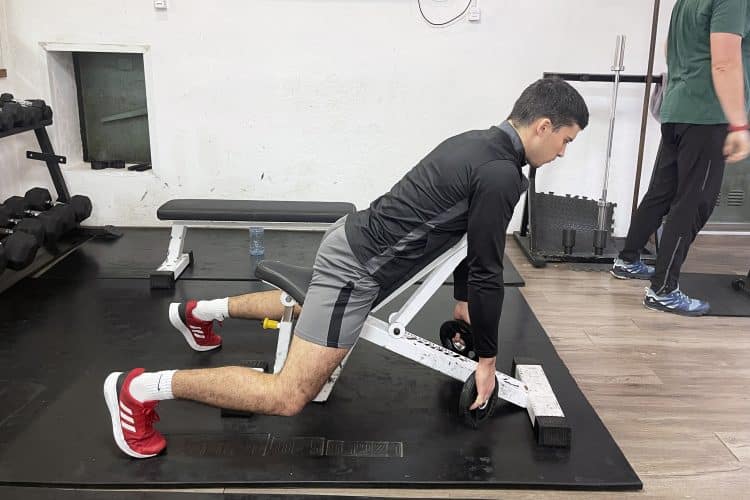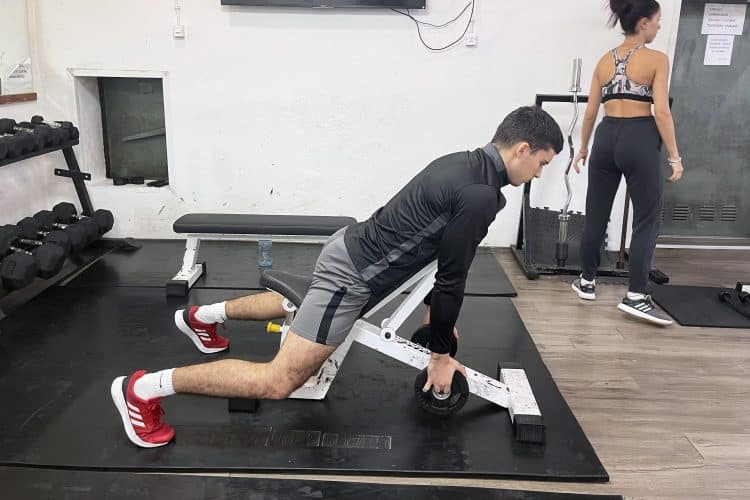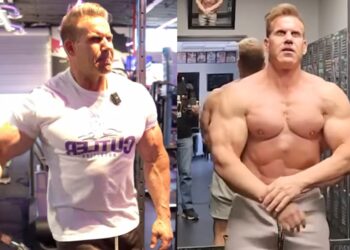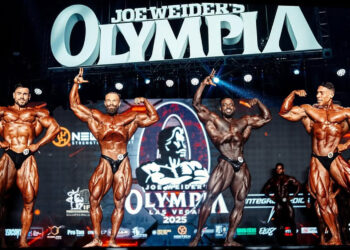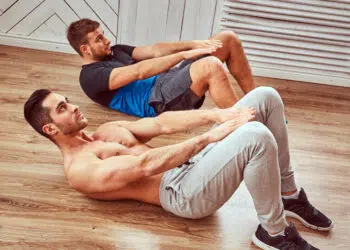Chest-supported Y raises are an effective exercise that can help build strength, promote hypertrophy, and improve posture.
A study titled “Variation of muscle recruitment during exercises performed below horizontal arm elevation that target the lower trapezius” claims that prone Y raises are the gold standard exercise for recruitment of the lower trapezius. (1)
Another randomized controlled trial on PubMed suggests that a lower trapezius strengthening program effectively reduces neck dysfunction (2). In addition to that, it also improves lower trapezius muscle health, posture, and function.
In my experience with numerous clients, Y raises are excellent for beginner lifters. You can effectively implement them into your back workouts to improve posture and upper-back muscle development.
Below is an easy-to-understand chest-supported Y raises guide, covering everything from proper form and muscles worked to benefits and best variations and alternatives.
How To Perform Chest-Supported Y Raises
Here is how to do chest-supported Y raises correctly:
Level Up Your Fitness: Join our 💪 strong community in Fitness Volt Newsletter. Get daily inspiration, expert-backed workouts, nutrition tips, the latest in strength sports, and the support you need to reach your goals. Subscribe for free!
Step One — Assume the Starting Position
Set the incline of an adjustable bench between 30 and 45 degrees. Pick two small weights (dumbbells or weight plates) depending on your fitness level. Lie on your stomach on the bench. Place your feet on the floor and ensure stability with the balls of your feet. Let the weights hang so they are perpendicular to the floor.
Pro Tip: Don’t pick weights that are too heavy, as they can compromise your form. If you feel like you can’t perform exercise with any weight, just stick to the bodyweight version.
Step Two — Perform Y Raises
With your elbows fully extended, lift both hands towards the ceiling, following the Y pattern. The angle between your head and shoulders should be around 45 degrees or less. Your arms and torso should be in a straight line at the isometric contraction point. Hold this position for one second.
Pro Tip: Contract your glutes and core muscles to stabilize your body and isolate the movement of your upper back.
Step Three — Return the Weights to the Starting Position
Slowly lower the weights to the starting position. During this phase, inhale and prepare for the next rep.
Pro Tip: Don’t drop the weights to the starting position. Controlled movement is key during the lowering phase. Slow eccentrics will better target your traps, rhombs, and posterior deltoids.
What Muscles Do the Chest-Supported Y Raise Target?
Here are the primary muscles targetted during this exercise:
- Posterior deltoids
- Trapezius
- Rhomboids
Also, here are the secondary muscles trained:
- Rotator cuff muscles
- Latissimus dorsi
- Erector spinae
- Serratus anterior
Benefits of Chest-Supported Y Raises
While I noticed numerous benefits from performing chest-supported Y raises, some stand out. Let’s tackle each of these below:
Improved Posture and Shoulder Stability
Chest-supported Y raises are excellent at improving your overall posture and shoulder stability. They effectively target delts, traps, and rhomboids and strengthen the postural muscles, which are crucial for keeping your spine and shoulders healthy and stable.
In particular, Y raises target lower trapezius muscles, which are responsible for neck stability. This muscle’s weakness, inactivity, or stiffness usually results in neck pain.
Reduced Lower Back Strain
When you add the adjustable bench to the equation, performing this exercise without stress on your lower back becomes much easier. The chest-supported version of Y raises will effectively isolate your upper back muscles.
The isolation lets you fully concentrate on the upper back muscle movement without feeling pain and excessive stress on your lumbar spine. It is much less stressful compared to the bent-over standing Y raises variation.
Targeted Shoulder Development
Chest-supported Y raises are excellent at developing your shoulders. They primarily target your rear delts and smaller muscles around your shoulder blades. These muscles include infraspinatus and supraspinatus.
These muscles are crucial for healthy shoulder rotation and shoulder abduction. However, in my experience, most trainees and fitness enthusiasts neglect exercising these muscles separately.
Chest-Supported Y Raise Variations and Alternatives
The best chest-supported Y raise variations include T, W, and I raises. Additionally, the best alternatives include face pulls and bent-over lateral raises, both excellent for improving your posture and posterior deltoid strength. Let’s cover each of these below:
Level Up Your Fitness: Join our 💪 strong community in Fitness Volt Newsletter. Get daily inspiration, expert-backed workouts, nutrition tips, the latest in strength sports, and the support you need to reach your goals. Subscribe for free!
Chest-Supported T Raises
Chest-supported T raises are excellent at targeting your middle deltoids and upper and middle trapezius fibers. They also target rhomboids, posterior deltoids, and rotator cuff muscles to a lesser extent.
Steps:
- Set the incline of an adjustable bench between 30 and 45 degrees.
- Pick two small weights or perform the exercise without them, depending on your current fitness level.
- Lie on the bench on your stomach and place your feet on the floor.
- With your elbows fully extended, lift both hands towards the ceiling, following the T pattern.
- The angle between your head and shoulders must be 90 degrees. When you reach the top position, hold it for one second.
- Slowly lower the weights to the starting position.
Pro Tip: Focus on squeezing your shoulder blades together at the movement’s top. This will maximize the engagement of the middle trapezius and rhomboids.
Chest-Supported W Raises
Chest-supported W raises primarily target posterior deltoids and lower and middle fibers of your traps. In addition to that, they also work your rotator cuff muscles and long head of biceps brachii.
Steps:
- Set an adjustable bench between 30 and 50 degrees.
- Pick two small weights, depending on your current fitness level.
- Lie on your stomach on the incline bench, and ensure stability with the balls of your feet.
- Lift both of your hands towards the ceiling, following the W pattern.
- This entails bending your shoulders and elbows to form the “W” shape.
- When you reach the top position, hold it for one second.
- Slowly lower the weights towards the starting position.
Pro Tip: During the W raise, concentrate on externally rotating your shoulders during the concentric phase. This will intensify the engagement of the posterior deltoids and rotator cuff muscles.
Chest-Supported I Raises
Chest-supported I raise is another exercise that targets your anterior deltoids and upper trapezius fibers. However, they also work your serratus anterior and supraspinatus, the muscles that are the part of your rotator cuff.
Steps:
- Set an incline bench between 30 and 45 degrees.
- Pick two small weights, depending on your current fitness level.
- Lie on your stomach on the incline bench.
- Keep your elbows fully extended. Lift the weight straight overhead toward the ceiling, following the I pattern.
- When you reach the top position, hold it for one second.
- Slowly lower the weights towards the starting position.
- Proceed with the next rep.
Pro Tip: Keep your neck in a neutral position to avoid straining it. Focus on using your anterior deltoids and upper trapezius to lift the arms.
Face Pulls
Face pulls are one of my favorite corrective exercises. They are excellent at targeting small and large muscles around your shoulder blades. These are primarily responsible for keeping your posture intact.
Steps:
- Pin an appropriate weight on the cable machine.
- Set the pulley at your chest level.
- Grab the rope with both hands and step back.
- Assume a shoulder-width athletic stance.
- Slightly bend your knees and hips for more stability.
- Pull the rope towards your face, but ensure your elbows are always higher than the rope.
- When you reach the end range of motion, hold it for one second.
- Reverse the motion to return to the starting position.
Pro Tip: Focus on squeezing your shoulder blades together at the end of the pull and hold briefly for a second. This will enhance muscle activation and improve posture-related strength.
Bent-Over Lateral Raises
Bent-over lateral raises are great for targeting your posterior delts and middle traps. I often use them as a compound set for overhead press variations, especially when working on muscle hypertrophy.
Steps:
- Pick two dumbbells of appropriate weight.
- Assume the starting standing position with your feet hip-width apart.
- Slightly bend your knees and keep them in that position during the entire exercise.
- Bend forward until your trunk is parallel to the ground.
- Ensure your back is straight during the whole exercise.
- Raise both dumbbells laterally. Pause and contract your shoulders at the top.
- Return the dumbbells to the starting position.
- Repeat for desired reps.
Pro Tip: Contract your core and leg muscles to stabilize the movement. Also, add that little extra squeeze of your shoulder blades at the top.
FAQs
What equipment is needed for chest-supported Y raises?
You can do chest-supported Y raises with dumbbells or small weight plates. In addition to that, you can also perform Y raises with your body weight only, which is great for beginners. Resistance bands and cables are other equipment you can experiment with.
What are the common mistakes to avoid when doing chest-supported Y raises?
The biggest and most common mistakes you must avoid when doing chest-supported Y raises are picking the wrong weight, not stabilizing your body properly, and rushing through the reps.
The last is crucial, so you must avoid lifting the weight too quickly, which results in less muscle engagement. You want to perform Y raises with utmost control and stability while focusing most of your energy on proper form and weight trajectory.
How can I incorporate chest-supported Y raises into my shoulder workout routine?
Incorporate chest-supported Y raises as a supporting back exercise in your workouts. You can perform them towards the end of your workout. You can also couple it with other accessory exercises, such as internal/external shoulder rotations and hip circles, to form a standalone workout.
Are chest-supported Y raises suitable for beginners?
Absolutely. Chest-supported Y raises are not just suitable for beginners but, in my opinion, mandatory. They represent an excellent starting point for developing upper back and postural strength before transitioning to more complex exercises.
What is the difference between a trap-3 raise and a Y raise?
The trap-3 raise uses a grip and arm path that eliminates tension from your medial deltoids. Y-raises are primarily performed with your palms pronated/downward. However, you must understand that the grip angle and arm path can vary.
Wrapping Up
Chest-supported Y raises are excellent for developing upper back muscles such as traps, rhomboids, and posterior deltoids. Incorporating this exercise in your workouts will improve your posture and shoulder stability and build your shoulder muscles further while also reducing the stress on your lower back because of the bench support.
I advise incorporating Y raises towards the end of your back workouts or as a standalone workout if you couple it with additional accessory exercises. In the comments below, let me know your thoughts on chest-supported Y raises and how you program them in your workouts.
References
- Garcia JF, Herrera C, Maciukiewicz JM, Anderson RE, Ribeiro DC, Dickerson CR. Variation of muscle recruitment during exercises performed below horizontal arm elevation that target the lower trapezius: A repeated measures cross-sectional study on asymptomatic individuals. J Electromyogr Kinesiol. 2023;70:102777. doi:10.1016/j.jelekin.2023.102777
- Park SH, Lee MM. Effects of Lower Trapezius Strengthening Exercises on Pain, Dysfunction, Posture Alignment, Muscle Thickness and Contraction Rate in Patients with Neck Pain; Randomized Controlled Trial. Med Sci Monit. 2020;26:e920208. Published 2020 Mar 23. doi:10.12659/MSM.920208
Relevant Articles:
- Cable Y Raise Guide
- 11 Cable Chest Exercises to Develop Serious Pec Power
- A Dozen Lateral Raise Variations for Wider Shoulders
Interested in measuring your progress? Check out our strength standards for Face Pull.

